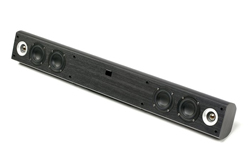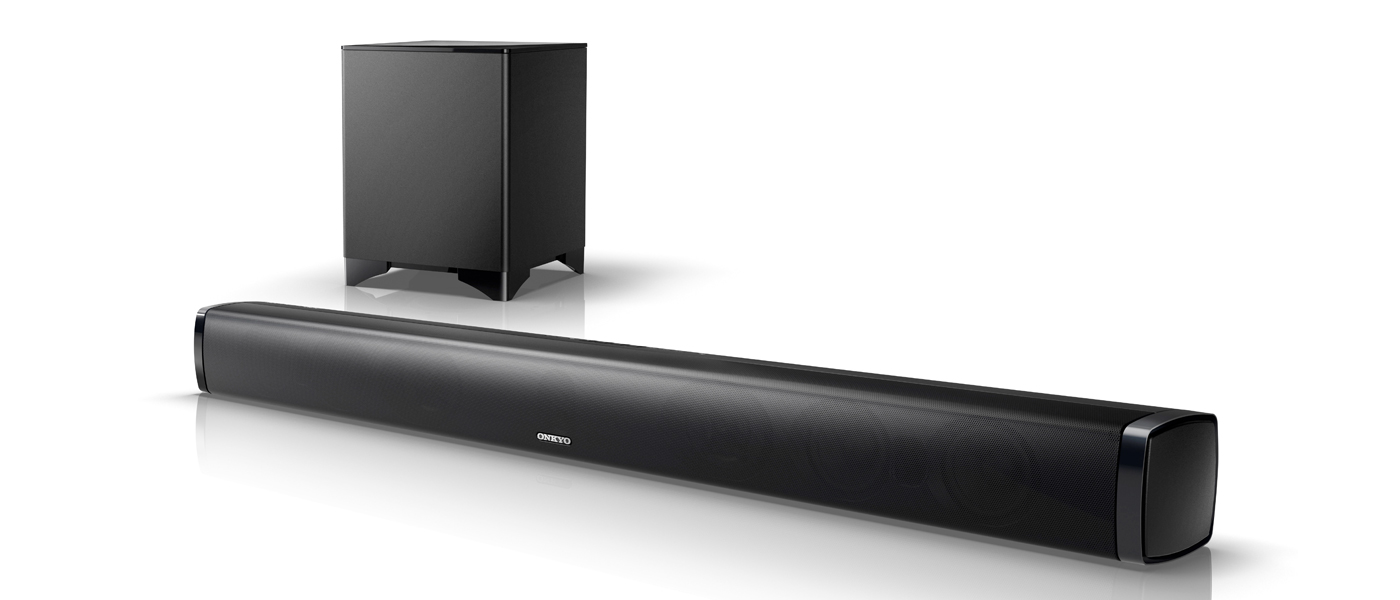Introduction to the Pinnacle T1 PBAR 2000 Powered Sound Bar

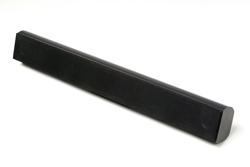
Don’t you often wonder why expensive televisions are sold with speakers that sound like they’re made of tissue paper and powered by a cell phone? No matter what the price of the set, it always seems that sound quality receives little of the design budget. This results in predictable audio quality – tinny, prone to distortion, and adequate only for the most basic of dialogue.
The good news is that there ARE alternatives! Pinnacle Speakers offers an array of high quality powered sound bars, surround speakers, subwoofers, and in-wall/in-ceiling speakers that can bring your television’s sound to life!
Pinnacle speakers are designed and manufactured in the U.S.A., and the company has been family owned and operated since 1976. Pinnacle warranties their products for three years, including parts and labor, indicating the company’s confidence in the engineering and construction quality. On some of Pinnacle’s products, warranties extend to as much as 12 years!
The T1 PBAR 2000 under review is a two-way, six driver, stereo, self-powered sound bar that has both analog and digital inputs. The bar is intended as a replacement for the internal speakers of your television or video display. The bar sports four 3″ diameter polypropylene woofers with durable butyl rubber surrounds that won’t fall apart like foam surrounds eventually do. The bar also has two 1″ soft dome tweeters with ferro-fluid cooling and wave-guides to improve room dispersion and coupling. The bar measures 38 inches wide by 4.5 inches high and only 3.5 inches deep. All surfaces except the front are curved to minimize internal reflections. The bar is finished in matte black wood grain and won’t reflect when placed in front of the video monitor.
PINNACLE T1 PBAR 2000 POWERED SOUND BAR SPECIFICATIONS
- Design: Six Driver Sound Bar
- Drivers: Two 1″ Soft-dome Tweeters with Wave Guides, Four 3″ Woofers
- Amplifier: Class D
- MFR: 100 Hz – 25 kHz ± 3 dB
- Inputs: One Coaxial Digital Connector, One Optical Toslink Digital Connector, One Analog L/R Input Pair
- Codecs: 16/44.1, MP3
- Dimensions: 4.5″ H x 38″ W x 3.5″ D
- Weight: 11.6 Pounds
- MSRP: $599
- Pinnacle Speakers
- SECRETS Tags: Pinnacle, Soundbars, Audio
The Design and Setup of the Pinnacle T1 PBAR 2000 Powered Sound Bar
When the T1 PBAR 2000 arrived, the first thing I noticed was the quality of the packing. Multiple hoops of custom-contoured foam ringed the sound bar at several places along the length, minimizing the likelihood of shipping damage. The power adapter and accessories were in a separate cardboard box. A plastic bag kept the accessories from scratching the sound bar in transit.
The grille cloth is attached to a wood frame with beefy metal pegs that prevent rattling. The pegs and their sockets feel very sturdy. The grille made no noise at all in use. Behind the grill are the drivers and an infrared (IR) sensor for the remote control.
The bar is supplied with a metal bracket, screws, and sheet-rock anchors for wall mounting. I did not wall mount the bar, but rather placed in on the stand in front of my TV during video use. For stereo evaluation, I placed the bar atop an equipment stand. Since the top, bottom, and back of the bar are curved, a self-adhesive plastic “foot” is supplied. By positioning the foot further forward or aft on the bottom, the bar can be angled to point upward at any angle desired. This is a clever design, but be sure to get the positioning right before you stick the foot to the bar.
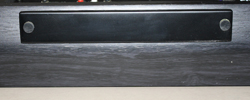
Accessories included with the sound bar are a digital coaxial cable, a digital optical (Toslink) cable, a stereo RCA analog cable pair, a remote control with batteries, and a power transformer with cord.
For reference, my AV room is roughly 25′ long, 15′ wide, and has 9′ ceilings. The sound bar was firing down the long center of the room during video use and across the short axis of the room when being evaluated for audio only.

The Pinnacle’s rear setup panel has a wide variety of options. With two types of digital inputs and an analog input pair, this bar should work with just about any current or legacy TV. One clever touch offered by Pinnacle is their “Remote Learning” feature. I needed this for my TV set. Normally, when the internal speakers are turned off on a television, the analog outputs remain live with variable volume controlled by the TV’s remote control. Samsung, for some obscure reason, designed my TV so that when the internal speakers are turned off, all outputs, digital and analog, remain at fixed volume.
Normally, this would mean that the sound bar’s remote control would be needed for volume (doubling the number of remote controls needed for the system). But with the Pinnacle, I merely pressed the buttons on the back of the bar to enable “learning mode,” and then pressed the “volume up,” “volume down,” and “mute” buttons on my TV’s remote. From then on, the Pinnacle sound bar’s volume and muting could be controlled from the Samsung TV’s remote control. This significantly simplified the use of the sound bar and is a valuable feature.
The Pinnacle also sports a gain switch, functional only for the analog inputs, that controls the maximum loudness to which the bar can be driven. It is helpful for TVs that happen to send exceptionally strong or weak analog signals. The gain of the sound bar’s amplifiers can be altered in 10-decibel steps from 20 to 30 to 40 dB. On my television, the center setting, 30 dB, was perfect, so I didn’t need to alter this, but for music, the 40 dB setting allowed higher volumes.
The Pinnacle’s back panel also has a multi-color LED showing the status of the sound bar. The LED changes color when a digital (blue) or analog (green) signal is present. When either signal is present, the bar automatically and immediately wakes up and plays. When no signal is present, the bar and its amplifiers go to sleep to save power, and the LED glows red to indicate that the bar is in standby mode.
The Pinnacle, unlike many sound bars, is not intended to provide artificial surround sound or to replace a separate audio-video receiver. Pinnacle has designed this product to simply replace the mediocre stereo speakers in existing televisions. For movies, DVDs, and Blu-Ray use, Pinnacle recommends attaching any disc player directly to the TV and then using the television’s audio outputs to feed the Pinnacle. The Pinnacle provides stereo only, so a receiver and full set of speakers would still be needed if surround were desired.
The Pinnacle has a variable line-out for a self-powered subwoofer, although I didn’t use the product in this manner. The owners’ manual does not specify what crossover frequency the sub-out uses.
I used the Pinnacle’s remote control when evaluating the bar as a music system, but while I was using TV mode, I preferred to use the television set’s remote. The Pinnacle remote worked as advertised, and volume adjustments were smooth. With the learning features of the sound bar itself, I think that most users will prefer to use their television’s remote in order to minimize the number of remote controls required. Fewer remote controls is always a better thing.

The Pinnacle T1 PBAR 2000 Powered Sound Bar In Use
When measured using a sweep tone from the Stereophile Test CD, the Pinnacle had audible bass response down to 50 Hz. although significantly reduced in amplitude. The Pinnacle comes to a more usable volume in the bass at between 60 and 70 Hz, and reaches full volume at 100. Therefore, if deeper bass is desired, a separate, self-powered subwoofer will be required. A number of companies including Pinnacle make satisfactory subwoofers that can be driven by the monophonic “Sub Out” analog jack on the sound bar.
Television Use
This sound bar lacks true deep bass but despite this, voices and music sounded significantly fuller than with the TV speakers alone. I noticed, as did others who are familiar with my room, that the Pinnacle provided significantly more detail than the TV’s built-in speakers. Voices, background details, and treble sounds (birds chirping, etc.) were clearer. On programs, such as talk shows, where multiple guests talk (or shout, or yell) at the same time, the Pinnacle seemed to separate the voices well. With the TV’s built-in speakers, such mixes often became an unintelligible muddle. With the Pinnacle in the system, each voice could be clearly followed.
The Pinnacle never sounded bright, nasal, distorted, or “shouty” with any program material. A variety of classical musical programs were viewed on the local PBS station with the sound bar in use. These were significantly enhanced by the higher quality audio from the sound bar. The Pinnacle never clipped that I could tell despite driving it to high volumes.
To test the ability of the sound bar to handle movie dialogue and music, several DVDs and Blu-Ray discs were used, including the original “Transformers” movie (on DVD) and the surreal “The Fifth Element” (on Blu-ray). As you might surmise, I enjoy Science Fiction…


Both movies were down-mixed to stereo by the players. The DVD was auditioned on an inexpensive Samsung player, and the blu-ray by an Oppo BDP-105. Although the expanded soundstage and surround information were present in the mix, the bar, being only a stereo speaker, could not recreate surround sound. Nevertheless, the bar did present movie dialogue in a very clear and articulate manner, and sound effects (explosions, crashes, etc.) were presented with far better fidelity and dynamics than the TV speakers could provide.
Music Use
The sound bar was set atop my 28″ tall equipment stand for audition. The program material came from a combination of digital (Toslink) input and analog input from an Apple Airport Express. Music was streamed both at 16/44.1 (CD-standard) and from YouTube sources (MP3). The drivers of the sound bar are too close to provide significant stereo separation, but some width of the stereo sound sources was still apparent.

On Balkan Beat Box’s “Dancing with the Moon” from their Nu-Med album, the horns and conga drums were clean and very realistic sounding. The two saxophones used by the band could be differentiated easily from each other and from the trombone.

On Us3’s “Cantaloop (Flip Fantasia),” the mix of the horns, drums, side comments, and the rapper’s voice were clear and separate rather than blending into a muddle. This, again, indicates what I think is the speaker’s greatest strength – the clear and articulate presentation of voice.
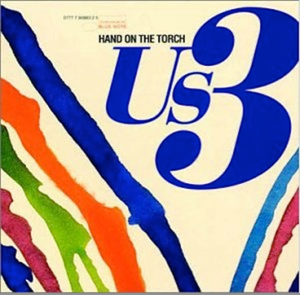
To test the “power” of the sound bar, I played Lady GaGa’s “Dance in the Dark.” This cut often sounds as if it had been mastered to play on a boom box – the bass can be overwhelming on a stereo. Despite the cut having deeper bass than what the sound bar could reproduce, the Pinnacle still did a credible job of presenting the impact of the bass without distortion.

So with both TV and with music, the intelligibility of dialogue was the greatest strength of this product. The bass, despite lacking the deepest frequencies, never distorted or sounded muddled, even at higher volumes. Treble was never excessive or irritating.
I also listened to one of my favorite bands, Walk Off The Earth in their “Speeches” cut. The voices and instruments were clear and distinct from each other, and vocal harmonies were particularly sweet sounding.
Conclusions About the Pinnacle T1 PBAR 2000 Powered Sound Bar
The Pinnacle T1 PBAR 2000 Powered Sound Bar is not the “Swiss Army knife” of audio kit, nor does it try to be. It does but one thing: substitute for your television’s internal speakers. Fortunately, it does that task very, very well. If you needed stereo for a small room, the Pinnacle might also suffice. Despite the lack of bass extension, the bass that the Pinnacle provided was significantly cleaner and stronger than that of the television. Bass response can also be enhanced by the use of an external powered subwoofer.
The midrange and treble are where the Pinnacle works its magic. The sound is clean, articulate, and goes far, far louder than the built-in speakers of the TV. The Pinnacle does so without distortion, harshness, or brightness. The quality of the sound bar is most noticeable and obvious when going from the Pinnacle back to the internal TV speakers. The instant step downward in sound quality from the TV’s speakers is a distinct disappointment!
Therefore, consider carefully how you wish to use a sound bar. If you want a replacement for an entire home theater system that attempts to provide movie surround sound and music in one simple package, then the Pinnacle may not be for you. Pinnacle does, however, offer more elaborate gear. If, on the other hand, you want only to provide a far, far more enjoyable audio experience for television viewing and occasional music listening, then the Pinnacle may be exactly what you need. The flexibility offered by the combination of analog and digital inputs ensures compatibility with virtually any television on the market and the unusual remote-control “Learning Mode” of the bar is an added perk.
I find the Pinnacle T1 PBAR 2000 a well conceived, well built, and easy-to-use product. It fulfills its intended purpose with excellent sound quality but without very deep bass. Convenient touches like the remote-learning feature make the bar easy to use. The bar’s appearance is inconspicuous. The sound bar does its job with a minimum of setup difficulty through a clear and helpful owners manual. All required accessories are included for stand or wall mounting. If higher quality TV sound is your primary goal, then the Pinnacle is well worth considering.
